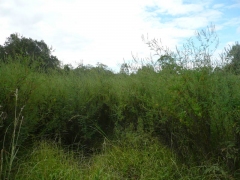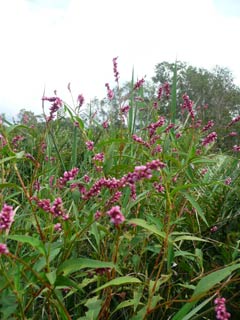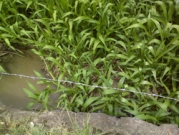
Logan and Albert Conservation Association

 Natural Resources, Mines and Energy Minister Stephen Robertson has launched a volunteer program aimed at harnessing people power for environmental projects across the state.
Natural Resources, Mines and Energy Minister Stephen Robertson has launched a volunteer program aimed at harnessing people power for environmental projects across the state.
Green Nomads is a new casual environmental volunteering placement program targeting the resources and skills of Australia's largest transient population, grey nomads. Mr Robertson said the initiative would have many benefits with volunteers working to care for the environment, while also building ties with follow workers and the communities they assist. This is an avenue for people who may have some spare time on their hands to assist in the protection and conservation of our unique natural resources.
"We are so lucky to live in such a wonderful state which has rich natural resources and this is a very practical way people can help ensure theses resources are maintained and protected," said Minister Stephen Robertson at the recent launch.
Championed by Queensland Water & Land Carers (QWaLC), a new website will link interested volunteers with environmental projects in the area they live or the areas where they are planning to travel. Possible environmental projects ranged from tree planting to gathering seeds of local native species. The Queensland Government is providing QWaLC with $300,000 for administration and insurance for this registered volunteer group.
"It is only through awareness that people can begin to take action to protect and care for the environment and this program allows people to develop that perspective while helping natural resources management groups with the challenges they face," Mr Robertson said.
The program website is www.greennomads.com.au
Registration is required for volunteers and information is available from the website for Community NRM Groups who would like to host Green Nomads. New groups applying for incorporation can also benefit from this program.
 The hunt is on for a pest weed being grown as a vegetable commonly used in Asian dishes.
The hunt is on for a pest weed being grown as a vegetable commonly used in Asian dishes.
Water Mimosa is the worst kind of weed in Queensland - a Class 1 declared weed that is highly invasive and endangers waterways. Minister for Primary Industries, Fisheries and Rural and Regional Queensland Tim Mulherin is asking south-east Queensland communities to help find it. "Water mimosa is an aquatic weed that can release nitrogen into waterways, which affects water quality and can lead to increased algae," Mr Mulherin said.
"The nitrogen levels also create the perfect growing environment for other declared water weeds, which kill our native wetland plants and fish."
Class 1 declared weeds are subject to eradication from the state and Biosecurity Queensland and local government officers will be out to track down this dangerous weed. Biosecurity Queensland is undertaking an awareness campaign to educate the public about why water mimosa is a declared weed and what their responsibilities are in relation to eradicating the weed.
 Information supplied by Barry Fitzpatrick April 2009.
Information supplied by Barry Fitzpatrick April 2009.
My weed of the month is ragweed (Ambrosia artemisiifolia). This enterprising American import is really taking over and does not miss an opportunity. Not only does it thrive anywhere in the bush where there has been a disturbance of the natural vegetation, but it also represents a severe health risk to humans, being regarded as the world's worst hay fever and asthma allergen plant. This has not been a good trade arrangement. After all, we gave the Americans our eucalypts and tea trees, and these are used to make stuff to sooth cold and flu symptoms and are probably good for asthma too.
I have seen (and hand pulled) from Cornubia Wetland Reserve, forests of ragweed two metres high and so densely packed that there was nothing else. It is interesting that this particular crop was located on a patch that the council had heavily sprayed in previous years, without any follow up work.
 Information supplied by Barry Fitzpatrick April 2009.
Information supplied by Barry Fitzpatrick April 2009.
My plant of the month for April is Persicaria elatior, a wetland smartweed with deep pink flowers. This plant has recently been discovered growing in the Cornubia Wetland Reserve, which is sandwiched between the M1, Beenleigh - Redland Bay Road, and light industrial and urban areas.
Listed as vulnerable under the Queensland Nature Conservation Act, Persicaria elatior has rarely been seen in Queensland, being recorded by the Queensland Herbarium only 6 times before this discovery.
But it is making a comeback. In summer last year, there were only three specimens found growing at the southern end of the reserve, and another eight at the northern end. This year there are around 30 plants in the southern section alone, and with new management plans being put in place for this recently acquired reserve, Persicaria elatior's future here looks secure.
 Hymenachne, one of Australia's top 20 weeds of concern, was found at Logan Village by Council staff January 2009 and later confirmed by the Queensland Herbarium. Logan City Council's pest management officers located and made the first recorded sighting of the infestation in South East Queensland.
Hymenachne, one of Australia's top 20 weeds of concern, was found at Logan Village by Council staff January 2009 and later confirmed by the Queensland Herbarium. Logan City Council's pest management officers located and made the first recorded sighting of the infestation in South East Queensland.
Like many of our weed species now, hymenachne was introduced to Australia from South America to provide ponded pasture for cattle. It has become an unwanted pest of stream banks, wetlands and irrigation ditches in coastal areas of central and north Queensland - and now at Logan Village is close to the Logan River. It is a declared a Class 2 species under Queensland's Land Protection (Pest and Stock Route Management) Act 2002 meaning it has already spread over substantial areas of Queensland, but its impact is so serious, we need to try to control it to avoid further spread onto properties still free from it.
Hymenachne grows from seed and from broken stem fragments. A single flower stalk can produce more than 4,000 seeds. Read more on biosecurity website at this page.
More information from Logan about plants to avoid is available here - before hymenachne was included